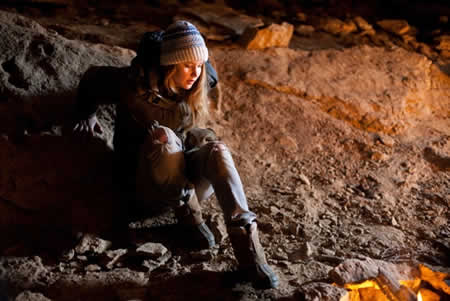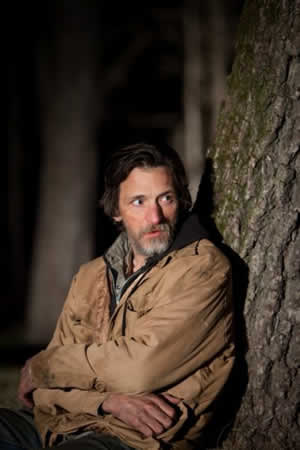 Way down in Missouri where I heard this melody,
Way down in Missouri where I heard this melody,
When I was a little child upon my Mommy’s knee;
The old folks were hummin’; their banjos were strummin’;
So sweet and low.
These lines, taken from the song Missouri Waltz, waft over the opening shots of Debra Granik’s Winter’s Bone (winner of the 2010 Sundance Film Festival Grand Jury Prize) with a haunting, melancholic subtlety that defines the film. Its lead character, Ree Dolly (Jennifer Lawrence) is a girl of seventeen trying desperately to hold together a family of two young children and a mentally unstable mother. Lawrence, bringing a gravity and wisdom to the role that belies her youth, moves through scene after scene with quiet strength and a rough kind of grace. Her natural, unaffected acting style is perfectly matched to the film’s somewhat barren setting, the unforgiving geography of the Missouri Ozarks, where the movie was shot on location.
It is against this harsh backdrop of rusty barbed wire, tin and wood shacks, and desolate woods that Ree has scrapped together a life for her two younger siblings, Sonny age 12 and Ashlee, 6. Her tenuous grip on a bearable existence unceremoniously shatters with a visit from the town’s sheriff. Unbeknownst to Ree, her father- a known crystal meth supplier named Jessup- has posted the house as bail before disappearing. With his court date only a week away, Ree takes it upon herself to track down her missing father and therefore save her house and her family.
The reception she receives during her search is chilling at best. The surrounding community, though mostly an assortment of cousins, aunts and uncles, provides little in the way of familial warmth and support. They appear to have an idea as to Jessup’s whereabouts but all Ree gets in response to her questions are cold, hostile stares and threats that she should keep her mouth shut if she knows what’s good for her. Even her uncle, Teardrop, acts sullen and closed-mouthed about his brother’s disappearance. Watching Ree’s struggle to find answer’s the audience is exposed to a complex social hierarchy, where blood and family ties are overshadowed by secrets, absolute power, and brutal violence. Themes of sacrifice and family clash and mingle in equal measures; for Ree, peace and an average standard of living are simple goals that appear out of reach.
Much of the film focuses on Ree’s treks through the Ozark wilderness to reach the people she wishes to question about her father’s whereabouts. The weather is bitterly cold, a dismal grey winter without even the  presences of snow to soften the terrain. In fact, the starkness of the landscape filters into every aspect of Winter’s Bone, with its muted color palette, subdued soundtrack and limited, pointed dialogue. Everything lends itself to a sparse atmosphere that manages to exude a kind of bare-bones loveliness.
presences of snow to soften the terrain. In fact, the starkness of the landscape filters into every aspect of Winter’s Bone, with its muted color palette, subdued soundtrack and limited, pointed dialogue. Everything lends itself to a sparse atmosphere that manages to exude a kind of bare-bones loveliness.
Despite its solemn atmosphere, the prevailing tone of Winter’s Bone is one of hope. Just when the audience is beginning to feel overwhelmed by the Ree’s bleak circumstances, Granik lingers over a shot of Sonny and Ashlee gleefully jumping on a trampoline or climbing over hay bales. These scenes of uncomplicated childhood joy act as a release, giving the audience time to catch its breath and steel itself for the family’s next hardship. Ree’s spirit and unflinching resolve, stunningly captured by Lawrence, also echo this message of hope. This is a girl that grasps at every means at her disposal to keep her family intact and does it with a grit and simple grace that is truly amazing to witness.
Another quality that keeps Winter’s Bone from sinking into a doom and gloom hopelessness is the powerful authenticity that pervades the film. Granik is uncompromising in her desire to capture a  real community and the cast, down to a man, is superb at accomplishing this feat. The characters look worn out; as if poverty is something they’ve grudgingly settled into and wear as another layer of clothing against the dry, aching cold. In a film where dialogue and plot are trimmed down to the bare necessities, every line must (and indeed does) carry tremendous weight and significance. The actors convey the full weight of an emotion in a measured phrase, steady gaze, and most importantly, what is left unsaid.
real community and the cast, down to a man, is superb at accomplishing this feat. The characters look worn out; as if poverty is something they’ve grudgingly settled into and wear as another layer of clothing against the dry, aching cold. In a film where dialogue and plot are trimmed down to the bare necessities, every line must (and indeed does) carry tremendous weight and significance. The actors convey the full weight of an emotion in a measured phrase, steady gaze, and most importantly, what is left unsaid.
At one point, siscussing her family’s future with the bail bondsman, Ree vents her frustration, fairly spitting out between clenched teeth, “How long til we get kicked off our own property?” Lawrence’s fierce delivery of the line reveals the tumult of emotions coursing through her, fear, defiance, and most of all, desperation. Actor John Hawkes as Teardrop delivers another of the film’s standout performances, his lean body moving with a dangerous, calculated stealth that can unpredictably explode into violence. Hawkes is Winter Bone’s wild card; will he rescue Ree or bring her greater tragedy?
As a whole, Winter’s Bone presents the audience with a story as enigmatic and complex as the Ozark wilderness that functions not only as the film’s backdrop but as a character in its own right. Ree’s search is laden with a suspense that builds in such subtle, tightly wound increments that the viewer unexpectedly finds himself holding his breath. Part drama, part mystery, this is a dense work that plays upon its quiet moments as effectively as its outwardly frightening scenes. Paired with a poignant, eerie setting and musical score, the resulting film stirs loose a response that lingers like the refrain of a haunting lullaby.

